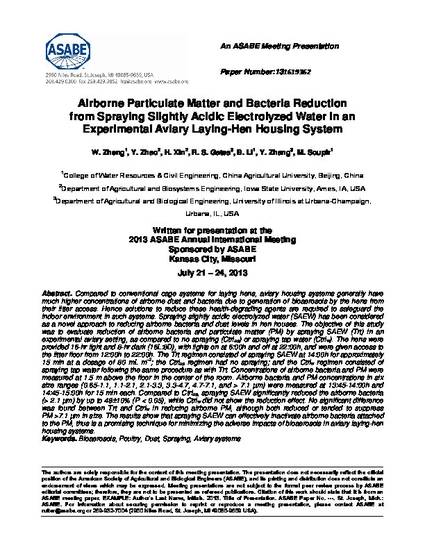
Compared to conventional cage systems for laying hens, aviary housing systems generally have much higher concentrations of airborne dust and bacteria due to generation of bioaerosols by the hens from their litter access. Hence solutions to reduce these health-degrading agents are required to safeguard the indoor environment in such systems. Spraying slightly acidic electrolyzed water (SAEW) has been considered as a novel approach to reducing airborne bacteria and dust levels in hen houses. The objective of this study was to evaluate reduction of airborne bacteria and particulate matter (PM) by spraying SAEW (Trt) in an experimental aviary setting, as compared to no spraying (Ctrlns) or spraying tap water (Ctrlw). The hens were provided 16-hr light and 8-hr dark (16L:8D), with lights on at 6:00h and off at 22:00h, and were given access to the litter floor from 12:00h to 22:00h. The Trt regimen consisted of spraying SAEW at 14:00h for approximately 15 min at a dosage of 80 mL m-2; the Ctrlns regimen had no spraying; and the Ctrlw regimen consisted of spraying tap water following the same procedure as with Trt. Concentrations of airborne bacteria and PM were measured at 1.5 m above the floor in the center of the room. Airborne bacteria and PM concentrations in six size ranges (0.65-1.1, 1.1-2.1, 2.1-3.3, 3.3-4.7, 4.7-7.1, and > 7.1 µm) were measured at 13:45-14:00h and 14:45-15:00h for 15 min each. Compared to Ctrlns, spraying SAEW significantly reduced the airborne bacteria (> 2.1 µm) by up to 49±10% (P < 0.05), while Ctrlw did not show the reduction effect. No significant difference was found between Trt and Ctrlw in reducing airborne PM, although both reduced or tended to suppress PM >7.1 µm in size. The results show that spraying SAEW can effectively inactivate airborne bacteria attached to the PM, thus is a promising technique for minimizing the adverse impacts of bioaerosols in aviary laying-hen housing systems.
Available at: http://works.bepress.com/richard-gates/16/
